
Recapture nature on Roosevelt Island
WASHINGTON, D.C. —Walking through the Mount Vernon Trails in Washington, D.C., is a unique experience that brings many closer to nature. But it is the unkept environment of Roosevelt Island in the Potomac River here that attracts the most avid nature lovers.
Nature lovers like Harry and John, who chose to not to give their last names, were two men I came across in the wooded terrain of the 88-acre island who moments earlier had spotted a bald eagle.
Both long time residents of Dupont Circle in Washington, the two are an ideal example of those that seek out nature and have found that Roosevelt Island is wonderful sanctuary where stunning scenery comes together with a diverse community of species.
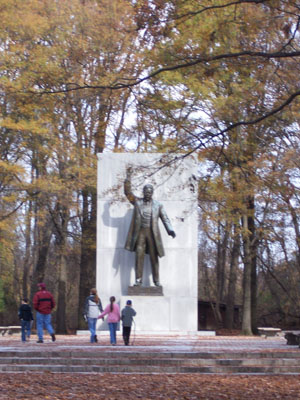 |
The statue of President Theodore Roosevelt on Roosevelt Island in the Potomac River in Washington, D.C. (Photos by Diana Offutt). |
“We come here almost every weekend,” John says from underneath his grey winter cap. They both are outfitted in a classic ‘bird watching’ uniform consisting of backpacks, binnoculars, and hiking boots. Like many people who visit Roosevelt Island, Harry and John commute.
“We don’t have a car so sometimes we walk or we take the little commuter bus and cross the Key Bridge. The walk from Dupont takes us about 50 minutes,” John said.
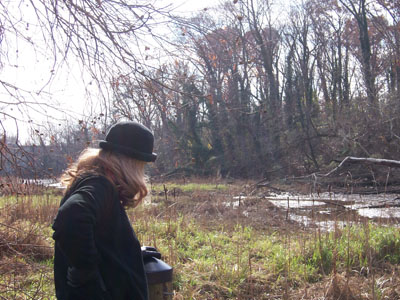 For most local visitors the island provides a place of solitude free from the traffic jams and busy streets of the metropolitan area.
For most local visitors the island provides a place of solitude free from the traffic jams and busy streets of the metropolitan area.
But Roosevelt Island, just across a stretch of the river from Foggy Bottom and near the Lincoln Memorial, is very different from most city parks– such as the National Mall in Washington or Central Park in New York– because it is mostly unkept, more like like Yellowstone or Shenandoah or some of the region’s national forests.
This is a reflection and a memorial to Theodore Roosevelt’s vision of the conservation of nature.
“A nation that destroys it’s soils destroys itself. Forests are the lungs of our land, purifying the air and giving fresh strength to our people,” Roosevelt once said.
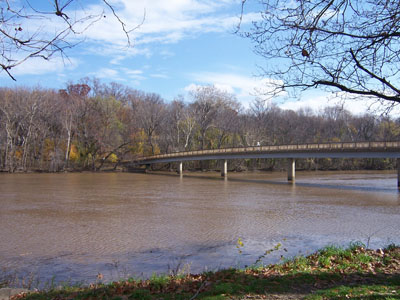 Our 26th President devoted his life to the conservation of nature.
Our 26th President devoted his life to the conservation of nature.
The island was built in 1973 and stretches 18.5 miles. It is part of the Mount Vernon Trail which lines the Potomac River for 18.5 miles from Mount Vernon in the south to Roosevelt Island on the northern end.
Part of the National Park Service, Roosevelt Island is a unique addition because it is one of the only city parks unkept much like some of the National Forests like Yellowstone or Shenandoah but located in Washington D.C.
The unkept nature of the island allows visitors like Harry and John to capture a bit of how Washington looked before its commercial development. Marshy bogs line the trails on the island. Deer and other animals run through the woods. The island provides a safe haven for animals free from the constant development of the area.
“We’ve been coming here for the last 20 years,” said Harry.
Both men have seen changes in the animals and the physical landscape of the island.
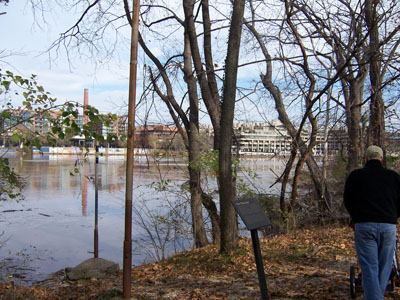 They demonstrate that you do not need a degree to be an expert when it comes the natural history of an area.
They demonstrate that you do not need a degree to be an expert when it comes the natural history of an area.
For instance they remembered times when the island had a snack shop along the bank of the Potomac River.
“We would sit by the river and drink our coffee and eat snacks. One time I saw a fox go by with a great big old catfish in his mouth,” John said.
John and Harry remember 20 years ago when it was rare to see a deer on the island. A far cry from the large deer population on the island today.
“We see everything from raccoons to foxes. I have even seen beavers along the banks of the Potomac River. We are not on a major fly route so we get all the left over birds. In the summertime we see the black billed cookoo. They make a muffled sound sort of like a car engine. Worldwide there are many species of the cookoo,” John said.
You do not have to be a nature lover to enjoy Roosevelt Island, it also has a rich history. Brochures at the island’s entrance provide a glimpse into the history of the island. Native Americans used the island as a seasonal fishing village.
Later it was land granted to Lord Baltimore by King Charles I after which it became a garden lined mansion for George Mason’s son in the 1790s. During the Civil War it was a training ground for the Union Army including the “First U.S. Colored Troops.”
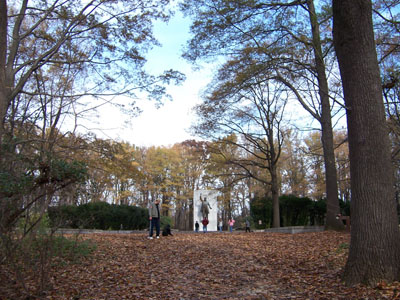 Today visitors are intrigued by the monument built in honor of Theodore Roosevelt In the center of the island.
Today visitors are intrigued by the monument built in honor of Theodore Roosevelt In the center of the island.
The tall statue is surrounded by two large fountains, a circular pool of water held by stone, and four giant stone plaques that read “Nature”, “Manhood,” “Youth,” and “Government” under which is an explanation of each word.
Roosevelt Island is an important piece of land for the cause of the conservation of nature. It provides an escape for humans and animals from the busy car filled city streets and the chatter of cellphones. The island, open from dawn to dusk, has a calendar with fun events for both adults and children.
Roosevelt Island if a unique addition to the National Parks Service because of unkept scenery amid a busy metropolitan city.
If You G0
Mount Vernon Trail, George Washington Memorial Parkway, Turkey Run Park McLean, Va. 22101, 703-289-2500, http://www.nps.gov/gwmp/mvt.html
National Park Service: http://www.nps.gov
Park Police: 202-619-7300
Safety and Regulations: Stay on the main trail or designated side trails. Stay on the right side of the trails.
Move left only to pass- give ample warning to the trail user in front of you before passing. Watch out for uneven pavement.
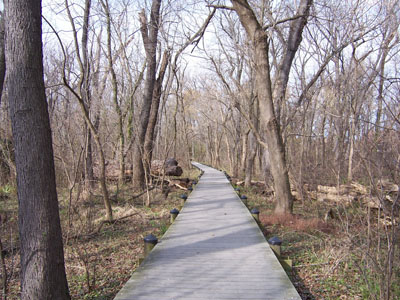 Use caution on wet boardwalks— they can be slippery. Be careful when crossing streets or if traveling with vehicle traffic. Firearms and metal detectors are prohibited.
Use caution on wet boardwalks— they can be slippery. Be careful when crossing streets or if traveling with vehicle traffic. Firearms and metal detectors are prohibited.
Lock your bikes in the racks provided. Pets must be on a leash at all times.
Be alert for poison ivy and ticks. Respect the privacy of property owners along the trail. Do not damage, remove or destroy any natural or cultural objects in the park— all are protected by federal law. Remember to bring drinks and snacks in case you get hungry.
Parking is free on a first come first basis. The lot is accessible from the northbound lanes of the George Washington Parkway.The entrance to the parking lot is located just north of the Roosevelt Bridge.
Southbound traffic: take Theodore Roosevelt Bridge to Constitution Avenue. Take a right on 23rd Street and cross Memorial Bridge. Once on the bridge, bear right to return to the G.W. Parkway. The nearest metro stop is the Rosslyn.

Comments are Closed